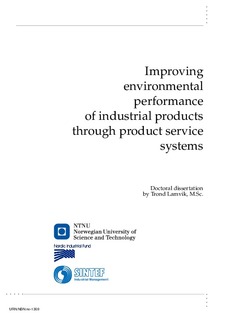| dc.contributor.author | Lamvik, Trond | nb_NO |
| dc.date.accessioned | 2014-12-19T11:25:04Z | |
| dc.date.available | 2014-12-19T11:25:04Z | |
| dc.date.created | 2001-06-18 | nb_NO |
| dc.date.issued | 2001 | nb_NO |
| dc.identifier | 125964 | nb_NO |
| dc.identifier.isbn | 82-471-5307-6 | nb_NO |
| dc.identifier.uri | http://hdl.handle.net/11250/231304 | |
| dc.description.abstract | This dissertation deals with the unintended sideeffects of utilizing resources and causing environmental load.
The intention of this report is to contribute to a leap improvement in enviornmental performance of industrial products. The results of the dissertation are directed towards companies that want to eliminate, or at best reduce the unintended side effects of their activities and industrial products.
The results are directed to the research community as a contribution to research on the effect of a shift from product-based to function-based economic system, and the potential improvement in environmental performance this may imply.
The main contribution of this dissertation is a strategy for developing product service combinations and thereby closing material loops of industrial products. The result is based upon product development models, creative tools and performance measurement combined with the resolution of the basic physical contradiction into a four step strategy for a long term shift of a business model based on product service combinations instead of products only. The fourstep strategy involves traditional product development models with focus on holistic lifespan thinking. Furthermore, emphasize is made to the need to include the creative tools to conquer psychological inertia and barriers for leap improvements in environmental performance.
The strategy is mainly based upon logical resoning and thought experiments and combined with observations in industry. It is difficult to give a final proof of the usefulness of the strategy, due to the time needed to perform such a strategic shift in the core activities of a business.This research has furthermore contributed to
• a clarification of the source of environmental load during the meetings between product and product life system where any action to reduce the original load will result in load of its own which means that the fundamental cause of load is still not resolved. Any attempt to remove the fundamental cause of side-effect is a true physical contradiction which violates the second law of thermodynamics.
• a clearer understanding of the need not only to integrate the different disciplines across a company’s operations, but also integrate along the value chain to capture the valuable information which arise during meetings between product and product life systems.
• a deeper understanding of the need to include creative techniques into the early phases of product development proejcts where dispositions for subsequent project phases and subsequent product life phases are disposed and locked against subsequent major modifications. Creative techniques contribute to the break out of existing mind patterns and contribute to the creation of solutions which reduce the business-as-usual pattern which acts as a barrier to leap improvement in environmental performance
• a clarification of the need to identify and develop the company’s environmental perspective. The need to develop strategies for improvingenvironmental performance of company internal processes, product systems and systemic networks of actors along the value chain is vital to achieve leap improvements in environemntal performance.
• a deeper understanding of the barriers to overcome to transform products-based business to service-based business. | nb_NO |
| dc.language | eng | nb_NO |
| dc.publisher | Fakultet for ingeniørvitenskap og teknologi | nb_NO |
| dc.relation.ispartofseries | Dr. ingeniøravhandling, 0809-103X; 2001:45 | nb_NO |
| dc.subject | | en_GB |
| dc.subject | Materialvetenskap | en_GB |
| dc.subject | TECHNOLOGY: Materials science | en_GB |
| dc.title | Improving Environmental Performance of Industrial Products through Product Service Systems | nb_NO |
| dc.type | Doctoral thesis | nb_NO |
| dc.source.pagenumber | 260 | nb_NO |
| dc.contributor.department | Norges teknisk-naturvitenskapelige universitet, Fakultet for ingeniørvitenskap og teknologi | nb_NO |
| dc.description.degree | dr.ing. | nb_NO |
| dc.description.degree | dr.ing. | en_GB |
